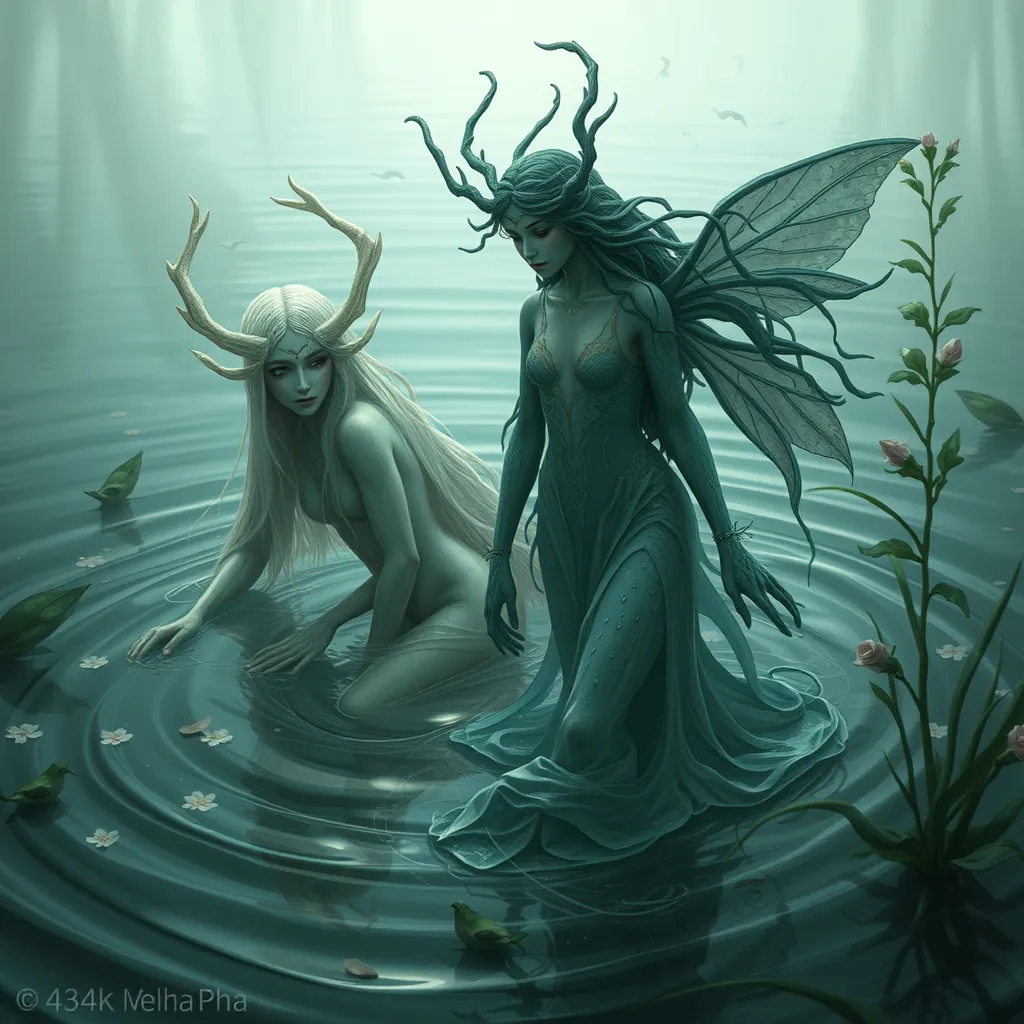The Nymphs of the Lake: Exploring the Lore of the Limnad and the Naiad
I. Introduction to Nymph Lore
Nymphs have long captivated the human imagination as ethereal beings that embody the essence of nature. In mythology, they are often depicted as beautiful maidens who are closely associated with various elements of the natural world.
The term “nymph” generally refers to a female spirit or minor deity in Greek mythology, usually associated with a particular location or landform. Among the most prominent nymphs are the Limnads and the Naiads, both of whom are linked with freshwater bodies but differ in their specific associations and characteristics.
The significance of these figures in ancient cultures cannot be overstated, as they often represented the life-giving properties of water and were invoked in various rituals and myths that celebrated fertility, beauty, and the natural world.
II. The Naiad: The Water Nymph of Rivers and Springs
A. Origins and characteristics of Naiads
Naiads are a specific type of water nymph primarily associated with freshwater sources such as rivers, streams, and springs. In Greek mythology, they are often depicted as young women with flowing hair, who are both alluring and elusive. Their connection to water signifies their role as nurturers and protectors of aquatic life.
B. Naiads in Greek mythology
In Greek mythology, Naiads are often portrayed as the daughters of the river gods, and they play prominent roles in various myths. For instance, they are known to be the companions of Artemis, the goddess of the hunt, and they are frequently depicted in stories that emphasize their beauty and their connection to nature.
One famous myth involves the Naiad named Echo, who was cursed to only repeat the words of others. Her tragic tale highlights the complexity of the relationships between nymphs and mortals, as well as the consequences of love and desire.
C. Symbolism and cultural significance
Naiads symbolize purity, beauty, and the life-giving aspects of freshwater. They are often associated with fertility and the nurturing qualities of nature, making them important figures in agricultural rituals. In ancient Greece, rivers were considered sacred, and Naiads were believed to protect these vital resources.
III. The Limnad: The Lake Nymph
A. Definition and distinguishing features of Limnads
Limnads are a lesser-known type of nymph that inhabit lakes and other still bodies of water. Unlike the more dynamic Naiads, Limnads are often portrayed as more tranquil and serene, embodying the stillness and depth of lakes. They are typically depicted as graceful figures, sometimes with features that reflect the calm and reflective nature of their habitats.
B. Historical references to Limnads in literature
References to Limnads can be found in various ancient texts, although they are less frequently mentioned than Naiads. Greek poets and playwrights sometimes alluded to Limnads in their works, emphasizing their connection to still waters and the mysteries that such environments hold.
For example, in some myths, Limnads were said to emerge from the depths of lakes to assist or hinder mortals, reflecting the dual nature of water as both a source of life and a potential threat.
C. Connection to specific geographical locations
Limnads are often tied to specific lakes or bodies of water in mythological narratives. Certain lakes in Greece are associated with particular Limnads, highlighting the local significance of these nymphs. The mythological tales surrounding these nymphs served to explain the origins of the lakes and their importance to the surrounding communities.
IV. Comparative Analysis: Naiads vs. Limnads
A. Similarities in appearance and attributes
Both Naiads and Limnads share similarities in their ethereal beauty and their roles as guardians of water. They are often depicted as young, attractive women who embody the characteristics of their respective environments.
B. Differences in habitats and roles within mythology
The primary difference between Naiads and Limnads lies in their habitats. Naiads are associated with flowing waters, while Limnads inhabit still lakes. This distinction influences their roles in mythology; Naiads are often depicted as more active and involved in the lives of mortals, while Limnads tend to represent a more passive, serene nature.
C. Interaction with humans and other mythological beings
Naiads frequently interact with mortals in myths, often forming romantic relationships or offering guidance. In contrast, Limnads are more enigmatic, sometimes appearing as benevolent figures or as guardians who wish to keep humans at bay from the secrets of the depths.
V. Artistic Representations of Nymphs
A. Depictions in classical and modern art
Nymphs, including Naiads and Limnads, have been popular subjects in art throughout history. Classical sculptures often depict these water nymphs in graceful poses, emphasizing their beauty and connection to nature. In modern art, nymphs are sometimes reimagined in more abstract forms, reflecting contemporary interpretations of beauty and femininity.
B. Influence of Naiads and Limnads on literature and poetry
The allure of nymphs has also made them a recurring theme in literature and poetry. Poets such as John Keats and Alfred Lord Tennyson have drawn inspiration from the imagery and symbolism of Naiads and Limnads, using them to explore themes of beauty, nature, and the transient nature of life.
C. Cultural adaptations and reinterpretations over time
As cultures evolve, the representations of nymphs have adapted to reflect changing societal values and ideas. In some contemporary works, nymphs are portrayed as empowered figures, reclaiming their agency and challenging traditional narratives.
VI. The Role of Nymphs in Nature and Spirituality
A. Nymphs as guardians of water sources
Nymphs were often viewed as guardians of the natural world, particularly water sources. They were believed to protect springs, rivers, and lakes, ensuring the health and purity of these vital resources.
B. Spiritual significance in ancient rituals and beliefs
In many ancient cultures, water was considered sacred, and rituals were performed to honor nymphs as part of agricultural practices and seasonal celebrations. These rituals often involved offerings to the nymphs to ensure a bountiful harvest and to appease the spirits of the waters.
C. Environmental symbolism and modern interpretations
Today, nymphs still hold significant environmental symbolism, representing the importance of water conservation and the protection of natural resources. In modern interpretations, they serve as reminders of the interconnectedness of life and the need to respect and preserve nature.
VII. Contemporary Relevance of Nymph Mythology
A. Revival of interest in nymphs in popular culture
In recent years, there has been a revival of interest in nymphs in popular culture, particularly in fantasy literature, movies, and television shows. They are often portrayed as mystical beings with a deep connection to nature, appealing to audiences’ fascination with the supernatural and the natural world.
B. Nymphs in modern fantasy literature and media
Contemporary fantasy literature often features nymphs as central characters, exploring their relationships with humans and their roles in larger narratives about nature and magic. Works such as “The Mortal Instruments” series and various adaptations of fairy tales have incorporated nymph-like beings, showcasing their enduring appeal.
C. Connection to contemporary environmental movements
As environmental movements gain momentum, nymphs serve as symbols of the beauty and fragility of nature. Their mythological roots remind us of the importance of protecting our water sources and the ecosystems that depend on them.
VIII. Conclusion: The Enduring Legacy of the Limnad and Naiad
A. Summary of key points
The Limnads and Naiads represent two captivating aspects of nymph lore, each embodying distinct characteristics and cultural significance. From their origins in ancient mythology to their contemporary relevance, these water nymphs continue to inspire and intrigue.
B. Reflection on the cultural significance of water nymphs
Water nymphs symbolize the beauty and power of nature, serving as reminders of humanity’s connection to the environment. Their stories reflect the ways in which ancient cultures revered water and sought to understand its mysteries.
C. Invitation for further exploration of mythological themes
As we delve deeper into the rich tapestry of mythology, the stories of Limnads and Naiads offer valuable insights into our relationship with nature and the enduring legacy of ancient beliefs. Exploring these themes can inspire us to appreciate the beauty of the natural world and our responsibility to protect it.



